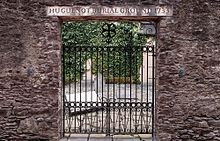
Glasnevin Cemetery is a large cemetery in Glasnevin, Dublin, Ireland which opened in 1832. It holds the graves and memorials of several notable figures, and has a museum.

A cemetery, burial ground, gravesite, graveyard, or a green space called a memorial park, is a place where the remains of dead people are buried or otherwise interred. The word cemetery implies that the land is specifically designated as a burial ground and originally applied to the Roman catacombs. The term graveyard is often used interchangeably with cemetery, but a graveyard primarily refers to a burial ground within a churchyard.

The Huguenots were a religious group of French Protestants who held to the Reformed (Calvinist) tradition of Protestantism. The term, which may be derived from the name of a Swiss political leader, the Genevan burgomaster Besançon Hugues (1491–1532), was in common use by the mid-16th century. Huguenot was frequently used in reference to those of the Reformed Church of France from the time of the Protestant Reformation. By contrast, the Protestant populations of eastern France, in Alsace, Moselle, and Montbéliard, were mainly Lutherans.

Macroom is a market town in County Cork, Ireland, located in the valley of the River Sullane, halfway between Cork city and Killarney. Its population has grown and receded over the centuries as it went through periods of war, famine and workhouses, forced emigration and intermittent prosperity. The 2011 census gave an urban population of 3,879 people, while the 2016 census recorded 3,765 people.

Dungarvan is a coastal town and harbour in County Waterford, on the south-east coast of Ireland. Prior to the merger of Waterford County Council with Waterford City Council in 2014, Dungarvan was the county town and administrative centre of County Waterford. Waterford City and County Council retains administrative offices in the town. The town's Irish name means "Garbhann's fort", referring to Saint Garbhann who founded a church there in the seventh century.

Portarlington, historically called Cooletoodera, is a town on the border of County Laois and County Offaly, Ireland. The River Barrow forms the border. Portarlington is around 70 kilometres (43 mi) west of Dublin. The town was recorded in the 2022 census as having a population of 9,288.

Kilcrea Friary is a ruined medieval abbey located near Ovens, County Cork, Ireland. Both the friary and Kilcrea Castle, located in ruin to the west, were built by Observant Franciscans in the mid 15th century under the invitation of Cormac Láidir MacCarthy, Lord of Muskerry, as protection from English troops.

Ballintemple is a suburb of Cork city, Ireland. The village is situated on the east side of the city with its limits extending to the River Lee and the village of Blackrock further to the east. Originally, Ballintemple was a separate village but today it has been enclosed by the city.

The Augustinian Priory of St Mary, most commonly referred to as Bridgetown Priory and also as Bridgetown Abbey, is a ruined 13th-century Augustinian monastery of the Canons regular of St. Victor. It is located in Castletownroche, County Cork, Ireland near where the River Awbeg meets the Blackwater. Once an affluent monastery, it was dissolved by Henry VIII in 1541, and the ruins are currently managed by Cork County Council.

Trinity-St. Paul's Episcopal Church in New Rochelle in Westchester County, New York was added to the National Register of Historic Places in 2006. It is located at the northwest corner of Huguenot Street and Division Street. This church represents the body of the majority group of New Rochelle's founding Huguenot French Calvinistic congregation that conformed to the liturgy of the established Church of England in June 1709. King George III gave Trinity its first charter in 1762. After the American Revolutionary War, Trinity became a parish of the Protestant Episcopal Church of America.

Cross Bones is a disused post-medieval burial ground on Redcross Way in Southwark, south London. Up to 15,000 people are believed to have been buried there. It was closed in 1853.

St. Catherine's Church, on Thomas Street, in Dublin, Ireland, was originally built in 1185. It is located on what was once termed the "Slí Mhór", a key route that ran westwards across Ireland from Dublin. The church was rebuilt in its present form in the 18th century by John Smyth.

There was a St. Kevin's Church in what is now St. Kevin's Park, Camden Row, Dublin, Ireland at least as far as the 13th century. After the Reformation, it became an Anglican church. The original church was replaced around 1750 by a new one, closed in 1912 and now in ruins. Both churches were dedicated to Kevin of Glendalough. There is also a Catholic St. Kevin's Church a short distance away on Harrington Street.

The Cabbage Garden, also known as the Cabbage Patch, is a former burial ground in Dublin, Ireland. It is located off Upper Kevin Street in Dublin's south inner city. Used as a cemetery from 1666 until the 1890s, it is now laid-out as a public park.

Grangegorman Military Cemetery is a British military cemetery in Dublin, Ireland, located on Blackhorse Avenue, parallel to the Navan Road and beside the Phoenix Park.

Ballybough Cemetery is a Jewish cemetery in Ballybough, Dublin. Founded in 1718, it is Ireland's oldest Jewish cemetery.

Innishannon Tower is the ruin of a Huguenot chapel tower built beside the original church and graveyard in the town of Innishannon, County Cork.

Skiddy's Almshouse is the oldest inhabited building in the city of Cork. It was built in 1718 and finished in 1719.

North Main Street is a street and retail area in Cork City, Ireland. Joined by bridge with South Main Street in the 12th century, it formed the main thoroughfare within the original city walls of medieval Cork. As of the 21st century, it is predominantly occupied by commercial and retail premises, some of which are built upon earlier structures.





















